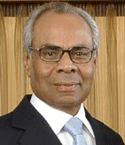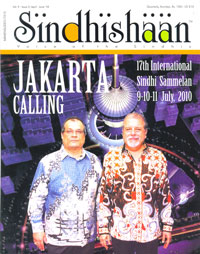MESSAGE FOR SAMMELAN
Srichand P. Hinduja
Chairman – Hinduja Group

My brothers Gopichand, Prakash and Ashok join me in complementing SINDHISHAAN for its special coverage on the 17th International Sindhi Sammelan held in Jakarta. I had expressed my views to the Sammelan on the need to preserve the unique customs, traditions and beliefs of our 5,000 year old rich Indus Valley Civilization which we call “Sindhyat” – I repeat them here for the wider readership of SINDHISHAAN.
What is Sindhayt, and why should we preserve it? This is the question uppermost in the minds of the generations of Sindhi community all over the world.
‘Sindhyat’ pertains to the distinct characteristics of Sindhi community, which distinguish it from other communities and give it a particular identity. The Sindhis are a peaceful, hardworking, hospitable, open-minded, philanthropic community whose nature is to give back to the society where he earns his wealth through entrepreneurship. They have build up the image of Indians abroad as prosperous and dependable people. They are an enterprising and industrious community – full of the spirit of faith and courage. They are free from inhibitions of caste and creed. In Sindhi Temples you will find the images of Lord Rama and Lord Krishna placed alongside with those of Lord Shiva, Goddess Durga and Guru Nanak. The Sindhis are cosmopolitan in their outlook. Someone said that today in India it is difficult to meet an Indian : every one belongs to one province or the other. The Sindhis are the only Indians in India! The Constitution of India has given Sindhi community full protection as well as freedom to assert its cultural identity. It is now up to us to feel the need and love for our cultural heritage and disseminate its knowledge among our younger generation and the world.
What are the distinct cultural traits, which are to be maintained for the development of Sindhi personality? A Sindhi firmly believes in Universal Brotherhood. He abhors violence, shirks taboos of caste, and possesses a refined temperament. Possessing these cultural traits in ample measure inherited from his forefathers, a Sindhi today finds himself equally at home in Hong Kong and Honolulu. Culture cannot be imposed from outside or learnt in schools and colleges. It grows within. The rich inheritance of Sindhi culture has taken thousands of years to evolve and it is the duty of every generation to preserve and pass it on to next generation because one cannot sustain for long on a borrowed culture. To live meaningfully one has to develop all their mental capabilities, which can best be promoted in an environment where one is deeply rooted.
The land of Sindh faced waves of foreigners and Sindhis themselves have travelled far and wide for trade. This has made them citizens of the world. Wherever they have gone, they have adapted to the local environment – be it culture, dress code or language.
Seminars, symposia, International cultural festivals can all help bring the Sindhi Diaspora on common platforms to interact and share their views on the preservation and promotion of Sindhi culture and heritage. There are many institutions in India and chapters in foreign countries helping develop the Sindhi ethos, which deserve the support of all well-wishers of the Sindhi community.


